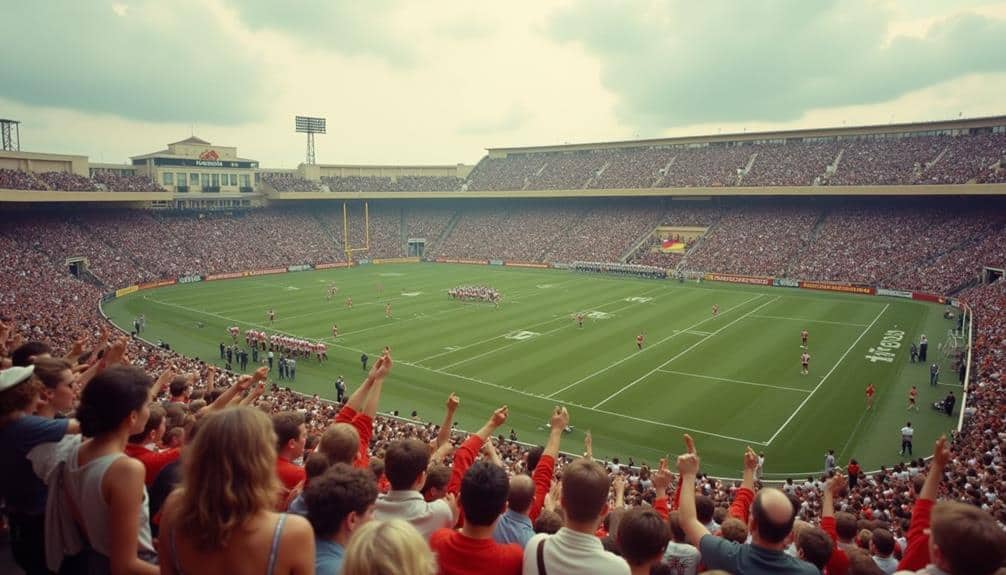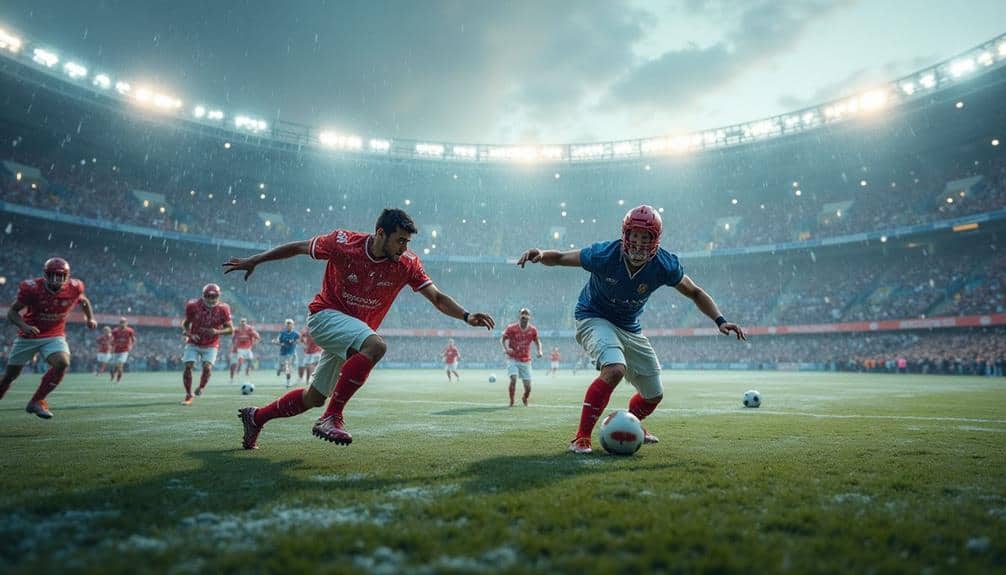The burgeoning fascination with American football in Russia presents a compelling case of cultural adoption and adaptation that began in earnest during the early 1990s. Despite grappling with limited infrastructure and competing with traditionally dominant sports, the creation of the Russian American Football League and various youth initiatives has sparked a grassroots movement. This exploration reveals how media coverage and the NFL’s strategic outreach have contributed to the sport’s growing popularity, fostering a vibrant fan base and local talent. What are the key factors driving this unexpected enthusiasm, and how might it shape the future of American football in Russia?
History of American Football in Russia

The history of American football in Russia is a demonstration of the sport’s universal appeal and adaptability. It began in the early 1990s, a period marked by significant cultural exchange between Russia and the United States. As Western influences permeated post-Soviet society, American football found its way into the Russian sports landscape. This era saw the establishment of the first amateur teams, largely driven by enthusiasts who had encountered the sport through media or during travels abroad.
Player recruitment in these formative years was primarily grassroots, relying on local athletes curious about this novel sport. Coaches and players from the United States occasionally visited Russia to offer training and share their expertise, further fostering a foundational understanding of the game. These interactions were instrumental in cultivating a dedicated core of players and supporters.
Initially, the sport’s growth was sporadic and faced numerous challenges, including limited access to proper equipment and facilities. However, the passion of the early adopters guaranteed that American football began to take root. Over time, this commitment laid the groundwork for more structured development, setting the stage for a burgeoning interest that would eventually lead to the formation of organized leagues and competitive play.
Development of Russian Leagues
Building upon the foundational enthusiasm of the early 1990s, the development of Russian leagues marked a significant evolution in the country’s engagement with American football. This period saw a concerted effort to establish a formal structure for the sport, leading to the creation of several local and regional leagues. These leagues provided a platform for competitive play, fostering a robust football culture across Russia.
Central to this growth were grassroots initiatives that aimed to popularize the sport among the youth. Youth programs were established to introduce American football to a new generation, ensuring that young athletes received proper training and exposure. These programs often collaborated with schools and community organizations to promote participation and develop local talent.
Additionally, the formation of the Russian American Football League (RAFL) in 2002 was a pivotal moment. The RAFL unified various regional leagues under a national umbrella, standardizing rules and regulations, and organizing national championships. This league structure not only enhanced the level of competition but also provided a clear pathway for young players aspiring to professional careers.
Through these grassroots initiatives and youth programs, the development of Russian leagues has played a vital role in embedding American football within the country’s sports landscape.
Role of Media and Broadcasting

Amidst the burgeoning popularity of American football in Russia, media and broadcasting have played an essential role in fostering and sustaining interest in the sport. Extensive media coverage has guaranteed that fans stay informed and engaged, while strategic broadcasting rights agreements have brought high-quality game broadcasts to Russian audiences.
Sports journalism has adeptly chronicled the evolution of American football within the country, providing in-depth analyses and player profiles that deepen fan understanding.
Digital platforms have revolutionized how fans consume content, offering on-demand access to games, highlights, and exclusive interviews. This digital shift has facilitated fan engagement, allowing enthusiasts to follow their favorite teams and players closely.
Media partnerships between Russian and American broadcasters have further expanded the sport’s reach, ensuring that content is tailored to local preferences.
Social media has amplified the sport’s presence, enabling real-time interactions and fostering vibrant online communities. Advertising strategies have capitalized on this engagement, promoting merchandise and upcoming events effectively.
Russian Fan Culture
American football has lured the Russian fan culture, creating a unique and fervent community of enthusiasts. This burgeoning interest is evident in the regular fan gatherings that take place across major cities like Moscow and St. Petersburg. Fans convene in bars, public parks, and even private homes to watch live broadcasts, discuss game strategies, and celebrate victories.
These gatherings are not merely about watching the game; they are social events that foster camaraderie and collective enthusiasm.
Social media plays a pivotal role in sustaining this vibrant fan culture. Platforms like VKontakte and Instagram are teeming with fan pages, discussion groups, and live forums dedicated to American football.
These digital spaces allow fans to share their passion, exchange information about upcoming games, and organize meet-ups. They also serve as a conduit for new fans to immerse themselves in the sport, providing tutorials, game analysis, and historical context.
The combination of physical fan gatherings and active social media presence has cultivated a dynamic community that continues to grow.
This hybrid model of fan engagement guarantees that American football remains a prominent and celebrated activity within Russian sport culture.
Popular Russian Teams

Several prominent teams have emerged in Russia’s burgeoning American football scene, enchanting the attention of fans nationwide. Among these, the Moscow Patriots and the St. Petersburg Griffins stand out as perennial powerhouses, whose team rivalries add a thrilling dimension to the sport. Their encounters are marked by intense competition and fervent support from their respective fanbases, making every match a spectacle.
In addition to these top-tier teams, the Moscow Spartans and the Yaroslavl Rebels have also made significant contributions to the sport’s growth. The Spartans are celebrated for their disciplined approach and robust defense, while the Rebels are known for their dynamic offense and innovative strategies.
These teams have fostered a culture of continuous player development, ensuring that emerging talent is meticulously nurtured and given ample opportunities to shine. The commitment to player development is evident in the structured training programs and youth academies established by these teams.
Influence of the NFL
The rise of American football in Russia cannot be fully appreciated without acknowledging the noteworthy role played by the NFL. Through strategic initiatives such as international games and cultural exchange programs, the NFL has effectively introduced and popularized the sport within Russian borders.
The presence of NFL merchandise in Russian markets has also contributed to heightened fan engagement, allowing enthusiasts to display their support for their favorite teams and players.
In a bid to foster local talent, the NFL has invested in player recruitment and coaching clinics. These efforts not only enhance the skills of Russian athletes but also create a pipeline for potential NFL prospects.
Additionally, the establishment of youth programs has been instrumental in cultivating a new generation of football players who are passionate about the sport from an early age.
The NFL’s role extends beyond the field, encompassing aspects of sports diplomacy. By hosting international games and promoting cultural exchange, the league has strengthened ties between the United States and Russia.
This multifaceted approach has not only broadened the sport’s appeal but has also fostered a sense of community among fans. The NFL’s influence in Russia is therefore both profound and enduring, considerably shaping the country’s American football landscape.
Challenges and Opportunities

Steering the growth of American football in Russia presents both significant challenges and promising opportunities. Cultural differences pose an initial hurdle, as American football, with its complex rules and equipment, is unfamiliar to many Russians accustomed to soccer or ice hockey. Economic factors also influence the sport’s development; adequate funding for training facilities and equipment remains a key concern.
However, grassroots initiatives are beginning to make a difference. Local leagues and youth engagement programs are nurturing a new generation of players and fans. These efforts are essential for embedding the sport within the community fabric. Sponsorship opportunities are emerging as businesses recognize the sport’s potential for brand exposure, although securing consistent financial backing remains a challenge.
Training facilities are another critical area. Access to quality venues is limited, impacting the ability to train athletes effectively. Nevertheless, international collaborations with established American football organizations offer a pathway to improved infrastructure and knowledge transfer.
Fan demographics in Russia are evolving, with a growing interest among younger audiences. This trend presents a promising opportunity for the sport’s expansion. Harnessing this enthusiasm through targeted marketing and community events could further solidify American football’s foothold in Russia.
Future of the Sport in Russia
Envisioning the trajectory of American football in Russia requires an analysis of current trends and strategic initiatives. Key to the sport’s future success is youth engagement, which is already seeing promising developments. Russian schools and local clubs have increasingly adopted American football programs, fostering early interest and skill development among young athletes.
This grassroots approach is essential for building a sustainable talent pipeline that can feed into higher levels of competition.
Moreover, participation in international tournaments will be pivotal for the sport’s growth. Russian teams’ involvement in global events not only enhances their skills but also elevates the sport’s profile domestically. By competing on the world stage, Russian athletes gain exposure to diverse playing styles and high-caliber opponents, which is vital for their development.
The establishment of more robust training facilities and coaching programs is another necessary step. Investment in these areas will help bridge the gap between amateur and professional levels, ensuring that talent is nurtured effectively.
Collaborative efforts with established American football organizations can also provide valuable insights and resources.




